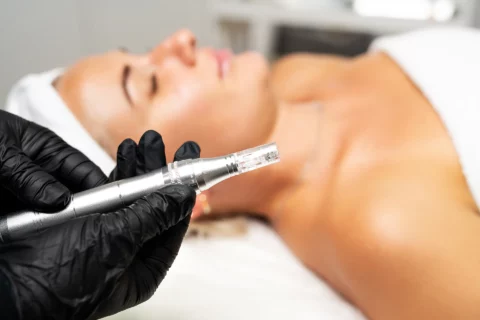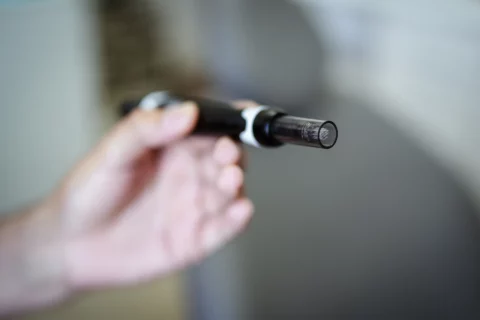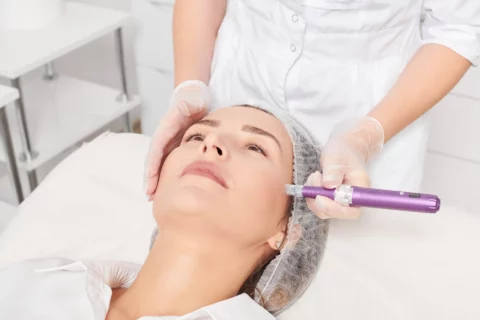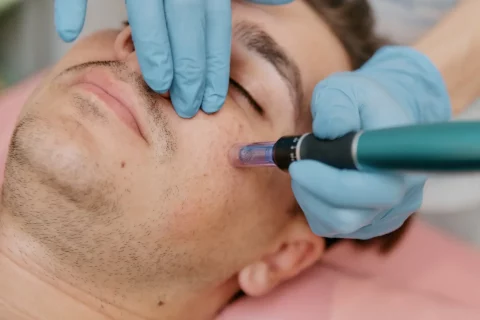Microneedling pens create controlled micro-injuries in the skin that trigger collagen production, with professional devices offering customizable depth settings for treating various concerns from wrinkles to scars. The resulting collagen regeneration process leads to improved skin texture, reduced signs of aging, and enhanced absorption of topical treatments.
Imagine being able to activate your skin’s natural healing powers with pinpoint precision, triggering a cascade of regeneration that works from within. This isn’t science fiction—it’s the reality of professional microneedling pens.
As our understanding of skin physiology advances, aesthetic professionals are harnessing the body’s innate collagen-producing mechanisms to address concerns ranging from fine lines to stubborn scars, all without surgery.
Collagen, the most abundant protein in our bodies, serves as the structural scaffolding that keeps skin firm, plump, and youthful. Unfortunately, collagen production declines by approximately 1% annually after age 20, contributing to visible aging.
Professional microneedling pens offer a targeted, minimally invasive solution that stimulates the skin’s natural collagen synthesis pathways through controlled micro-injury.
This article will decode the scientific mechanisms behind collagen induction through professional microneedling pens and explore the compelling clinical benefits this technology offers for skin rejuvenation and various dermatological concerns.
How Professional Microneedling Pens Work: The Foundational Science

At its core, professional microneedling operates on a simple yet profound principle: controlled injury leads to enhanced healing. These sophisticated devices utilize ultra-fine needles (typically ranging from 0.5mm to 2.5mm in length) to create thousands of microscopic punctures in the skin’s surface. These precisely engineered micro-injuries penetrate through the epidermis and into the dermis, triggering the body’s wound-healing response.
This process initiates three crucial phases of healing:
- Inflammation
- Proliferation
- Remodeling
During the initial inflammatory phase, platelets release growth factors and cytokines that serve as biochemical messengers, essentially signaling the skin that repair is needed. These molecular signals are the catalyst for the regenerative cascade that follows, directing cells to begin the rebuilding process.
Decoding Collagen Synthesis: The Body’s Regenerative Cascade
When microneedles penetrate the dermis, they activate specialized cells called fibroblasts—the primary architects of collagen production. These stimulated fibroblasts initiate neocollagenesis (new collagen formation) and neoelastinogenesis (new elastin production), creating fresh structural proteins that restore the skin’s supportive matrix.
The magic of professional microneedling lies in its ability to target the dermal layer, where approximately 70% of our collagen resides. Research has shown that creating these controlled micro-wounds can increase collagen production by up to 400% in treated areas, with studies documenting significant improvements in skin thickness and density within just a few months of treatment.
Precision and Depth Control: A Key Advantage of Professional Pens
Professional microneedling pens like the Dr. Pen devices offer crucial advantages over at-home rollers through their precision engineering and adjustable depth settings.
The ability to customize needle depth allows practitioners to target specific skin concerns with remarkable accuracy—treating superficial texture issues with more shallow penetration while addressing deeper scars or wrinkles with longer needles.
This customization is impossible with consumer-grade devices, which typically offer fixed, shallow needle depths that cannot effectively penetrate to the dermal layer where significant collagen induction occurs.
Professional-grade pens also offer superior needle quality, sterilization protocols, and consistent penetration patterns, all contributing to safer, more effective treatments.
Beyond Collagen: Other Scientific Effects of Microneedling
While collagen induction is the primary benefit, professional microneedling triggers additional beneficial processes. The treatment stimulates angiogenesis—the formation of new blood vessels—which enhances nutrient delivery and cellular turnover.
Microneedling creates temporary channels that increase the absorption of topical treatments, allowing active ingredients to reach deeper layers where they can work more effectively.
What are the Clinical Benefits of Collagen Induction through Professional Microneedling?

1. Addressing the Signs of Skin Aging
Professional microneedling’s collagen-inducing properties make it particularly effective for combating age-related skin changes. Patients typically experience reduction in the appearance of fine lines and wrinkles after a series of treatments, with improvements continuing for up to 12 months as collagen remodeling progresses.
The newly synthesized collagen and elastin fibers help restore the skin’s underlying support structure, improving firmness and elasticity. This structural reinforcement addresses sagging skin concerns, particularly in areas like the jawline, neck, and décolletage, where skin laxity is often prominent. Patients can achieve not only visible tightening but also enhanced skin quality and radiance due to improved cellular turnover.
2. Treating Scars and Texture Issues
Collagen induction therapy shows remarkable efficacy for various scarring concerns. For acne scars, professional microneedling works by breaking down the rigid, disorganized collagen bundles that form scar tissue while simultaneously stimulating new, properly-aligned collagen. Studies show improvements of 50-70% in acne scar appearance following multiple treatments.
The treatment also addresses surgical scars and stretch marks by triggering the remodeling of abnormal collagen patterns. Professional microneedling can improve stretch mark appearance, with best results seen on newer, reddish marks versus older, white ones.
For those concerned with enlarged pores, the collagen-building effects provide structural support around pore openings, reducing their visible diameter. Similarly, patients with uneven skin texture benefit from the accelerated cell renewal and improved dermal architecture, resulting in a smoother, more refined surface.
3. Combating Pigmentation Concerns
While primarily known for collagen induction, professional microneedling also helps address hyperpigmentation including sunspots, melasma, and post-inflammatory hyperpigmentation (PIH).
The treatment accelerates the shedding of pigmented cells while disrupting melanin clusters. When combined with brightening agents like vitamin C or tranexamic acid (which can be applied during or after treatment), results are often enhanced.
For optimal results with pigmentation concerns, many professionals combine microneedling with complementary treatments like chemical peels or laser therapy in a comprehensive approach.
What to Expect During a Professional Treatment
A professional microneedling session typically begins with thorough cleansing followed by application of a topical anesthetic to ensure comfort.
After about 30 minutes of numbing, the practitioner selects appropriate needle depths based on treatment areas and concerns—often using varying depths even within a single session (shallower for delicate areas like around the eyes, deeper for areas like the cheeks or forehead).
The actual microneedling process usually takes 15-30 minutes, during which the provider uses precise, methodical movements to ensure complete coverage while adjusting pressure and speed for optimal results.
Many professionals enhance the treatment by applying specialized serums containing growth factors, peptides, or hyaluronic acid during the procedure to leverage the increased absorption capacity.
The Importance of Professional Expertise for Optimal Collagen Induction and Safety
Professional training is crucial for effective and safe microneedling treatments. Expert practitioners understand the complexities of different skin types, conditions, and anatomical regions, allowing them to customize protocols for each patient. They can accurately determine appropriate needle depths—a critical factor in stimulating sufficient collagen production while minimizing risks.
Professional settings also ensure proper sterilization protocols, reducing infection risks. Additionally, trained providers can identify contraindications and manage potential complications like prolonged redness, hyperpigmentation, or granuloma formation.
Post-Treatment and the Collagen Remodeling Process
Immediately following treatment, patients typically experience redness and mild swelling resembling a sunburn, lasting 24-72 hours.
The visible regeneration process unfolds over time: initial inflammation subsides within days, the proliferation phase peaks at 2-3 weeks with active collagen synthesis, and the remodeling phase extends for months as new collagen matures and strengthens.
Most patients require 3-6 sessions spaced 4-6 weeks apart for optimal results, though visible improvements often appear after the first or second treatment.
The progressive nature of collagen induction means results continue improving for up to 12 months following the final session.
Conclusion

Professional microneedling pens represent one of the most scientifically sound approaches to stimulating natural collagen production. By harnessing the body’s inherent healing mechanisms, these devices trigger comprehensive dermal regeneration that addresses multiple skin concerns simultaneously—from wrinkles and laxity to scars and uneven texture.
The key to successful outcomes lies in choosing qualified professionals equipped with high-quality devices like those offered by Face Med Store, including the advanced Dr. Pen microneedling systems. These professionals combine technical expertise with an understanding of skin physiology to deliver safe, effective treatments tailored to individual needs.
As our understanding of collagen induction continues to evolve, professional microneedling stands as a cornerstone therapy for those seeking meaningful, natural-looking skin improvement without the downtime and risks associated with more invasive procedures. By investing in the skin’s own regenerative capabilities, patients can achieve lasting improvements that enhance both appearance and confidence.






